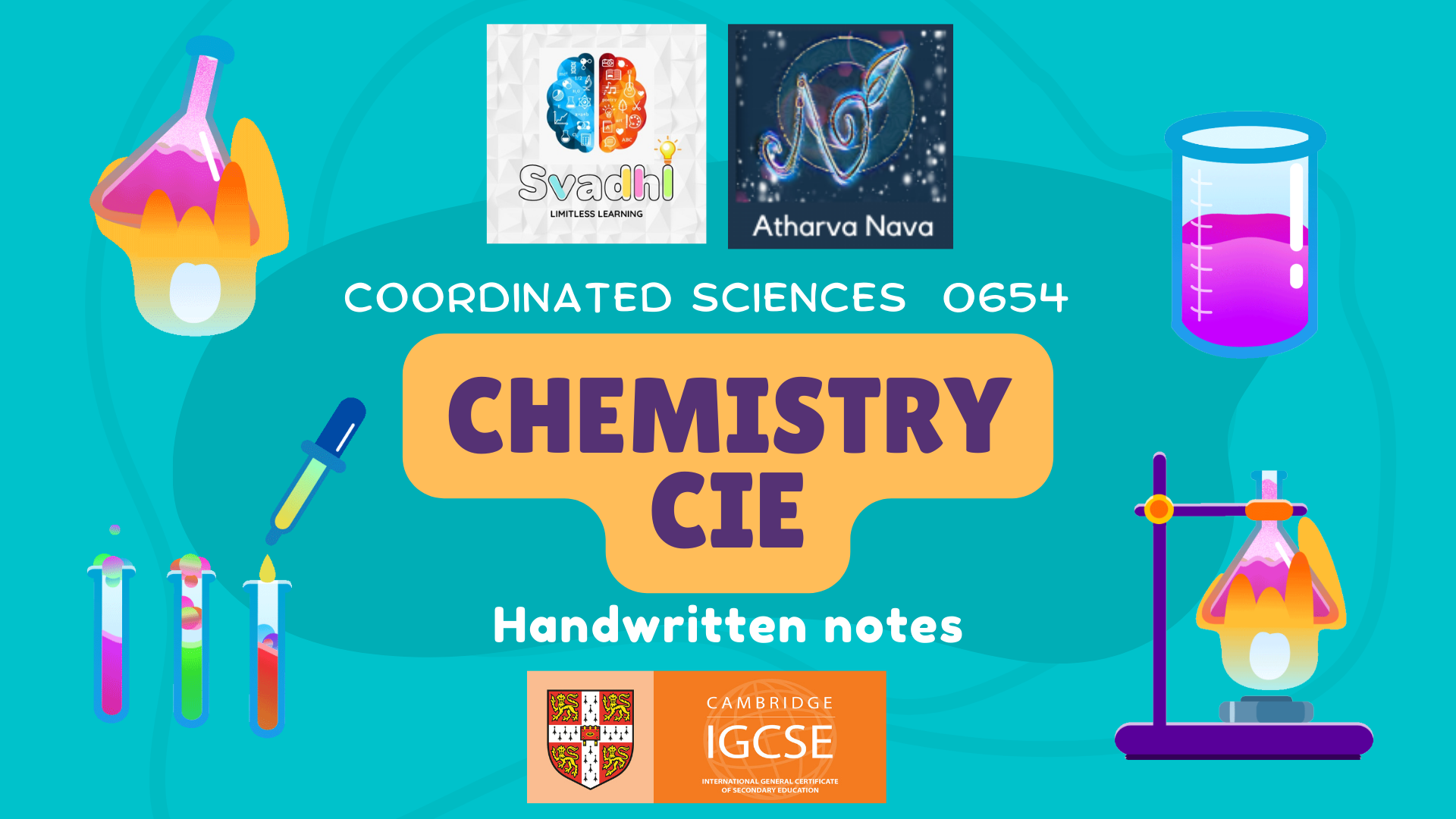IGCSE Chemistry revision just got easier! Handwritten notes and Graphics, chapter-wise downloads. Study smarter, not harder! Download Links in Red
Most of the diagrams/graphics can be credited to Save My Exams. We do not own these graphics.
Notes Pic is shown below for reference.
Author: Emma Le

C1. The Particulate Nature of Matter
- states of matter: solid, liquid, gas
- boiling/melting points and heating/cooling curves
- kinetic theory, diffusion
C2.1. Experimental techniques
C2.2. Criteria of purity: mixtures, paper chromatography, retention factor (Rf value)
C2.3. Methods of purification:
- mixture of solids, mixture of liquids
- filtration, crystallisation
- simple distillation, fractional distillation
C3. Atoms, molecules and compounds
C3.1. Physical + chemical changes
C3.2. Elements, compounds, mixtures
C3.3. Atomic structure + Periodic Table: electron shells, nucleon and atomic number, isotopes
C3.4. Ions and ionic bonds:
- electrostatic force of attraction between oppositely-charged ions
- lattice structure
C3.5 Molecules and covalent bonds: between non-metallic elements, weak intermolecular forces
C3.6. Macromolecules: allotropes of Carbon (diamond, graphite), silicion (IV) oxide
C4.1. Stoichiometry
- types of chemical formulae: structural, molecular, empirical
- deducing formulae of ionic compounds
- balancing equations
- ionic equations
C4.2. The mole
- Avogadro’s constant
- molar volume, calculating % composition
C5. Electricity and Chemistry (the hardest topic)
- electrolysis
- electrodes: anode, cathode
- electrolyte
- determining the gas produced
- electroplating
- industrial applications: manufacture of Cl2, H2, NaOH, Al from pure Al2O3 in molten cryolite
C6. Changes in Chemical Reactions
- exothermic and endothermic reactions
- H = enthalpy
C7.1. Rate (speed) of reaction
- setting up equipment
- factors: temperature, concentration, surface area, + catalyst
- explosive combustion
C7.2. Redox: oxidation states, oxidizing/reducing agents
C8.1. Properties of acids and bases:
- pH, litmus, methyl orange indicator
- reactions:
- neutralization: acid + base –> salt + water:
- acid + metal oxide
- acid + metal hydroxide
- acid + metal carbonate
- acid + metal –> salt + hydrogen
- alkalis + ammonium salts –> salt + water + ammonia
- neutralization: acid + base –> salt + water:
- pH and soil acidity
C8.2. Types of oxides: acidic, basic, neutral, amphoteric
C8.3. Preparation of salts:
- preparing soluble and insoluble salts
- methods: filtration, crystallisation, titration
C8.4. Identification of ions and gases: anions, cations, flame tests, gases
C9.1. The periodic table: group = valence electrons; period = number of electron shells
C9.2. Periodic trends
C9.3. Group properties: group I metals, group VII halogens
C9.4. Transition metals
C9.5. Noble gases
C10.1. Properties of metals: pure metals, alloys
C10.2. Reactivity series
C10.3. Extraction of metals from ores: Fe from hematite
C10.4. Uses of metals: Al, steel
C11.1. Water
- chemical tests for water: cobalt (II) chloride, anhydrous copper (II) sulphate
- water treatment for impurities: filtration + chlorination
C11.2. Air
- pollutants (CO, SO2, NOx)
- rusting, barrier methods, galvanising/ sacrificial protection
C11.3. Greenhouse gases CO2, CH4
C11.4. Nitrogen & Fertilisers: displacement of NH3, the Haber process (manufacture of ammonia)
C12-13. Sulfurs and Carbonates
C12. Sulfur: sources, uses, the Contact Process (manufacture of sulfuric acid H2SO4)
C13. Carbonates: manufacture of lime, uses of CaCO3
C14.1 Names of compounds
C14.2. Fuels: fractional distillation, properties of fractions (viscosity, color, boiling/melting point, volatility)
C14.3. Homologous series
C14.4. Alkanes
C14.5. Alkenes: catalytic cracking
C14.6. Alcohols
C14.7. Polymers
C14.8. Synthetic polymers: addition polymerisation, condensation polymerisation, nylon

